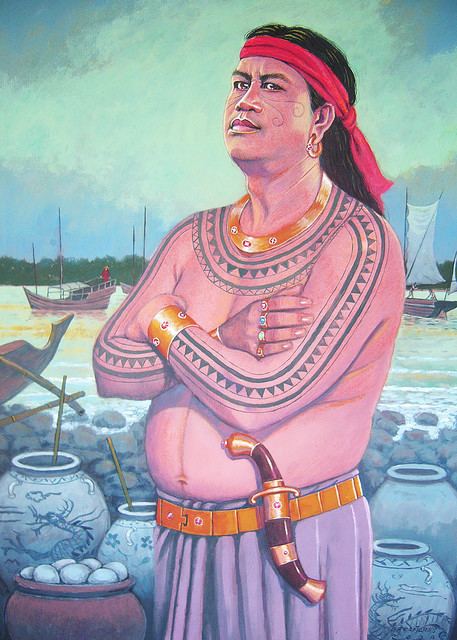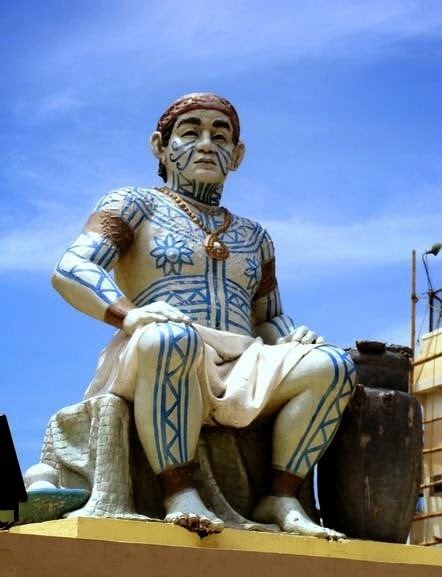Predecessor Sri Parang the Limp Spanish Carlos Religion Christianity Parents Sri Bantug | Consort Hara Humamay (Juana) Father Sri Bantug | |
 | ||
Similar | ||
Rajah Humabon, later baptized as Don Carlos, was the Rajah of Cebu at the time of Portuguese explorer Ferdinand Magellan's arrival in the Philippines in 1521. There is no official record of his existence before the Spanish contact in 1521, save for extensive narration by Italian historian Antonio Pigafetta on Humabon and the indigenous Philippine realms that existed prior to Spanish colonisation.
Contents
- Re enactment of the baptism of queen juana and rajah humabon
- Legendary accounts
- Spanish contact
- Conversion to Christianity
- References

Re enactment of the baptism of queen juana and rajah humabon
Legendary accounts

There is none official record on the origins of Rajah Humabon prior to the arrival of Magellan. According to tradition, Sri Hamabar (also known as Rajah Humabon) was the son of Sri Bantug, and the grandson of Sri Lumay.

Specifically, one of the native kings was Sri Lumay, a native from Sumatra, who settled in the Visayas and sired several sons, namely Alho, Ukob, Bantug. Sri Alho, who ruled a land known as Sialo which included the present-day towns of Carcar and Santander in the southern region of Cebu. Sri Ukob ruled a kingdom known as Nahalin in the north which included the present-day towns of Consolación, Liloan, Compostela, Danao, Carmen and Bantayan. He died in battle, fighting with the tribal group known as magalos from Mindanao.

The youngest of his sons was Sri Bantug who ruled a kingdom known as Singhapala (a variation of the Sanskrit Singha-Pura, "City of the Lion", which is the same root as "Singapore"), in a region which is now part of Cebu City, who died of disease and was succeeded by his son Sri Hamabar, also known as Rajah Humabon. Sri Bantug had a brother called Sri Parang the Limp, but could not rule because of his infirmity. Sri Parang handed his throne to his nephew Humabon as regent, and he became the Rajah (king) of Cebu.
Spanish contact

Parang he also had a young son, Tupas, who succeeded Humabon as king of Cebu. The phrase Cata Raya Chita was documented by historian Antonio Pigafetta to be a warning in the Malay language, from a merchant to the Rajah. Following Pigafetta's inscription, the phrase is creole Malay for "Kata-katanya adalah raya cita-cita". The phrase may mean "What they say is mainly ambitious": kata-kata ("words"), –nya (second person possessive), adalah ("is/are"), raya (great, main, large), cita-cita ("ambitious"). Another interpretation is that the phrase was spoken by merchants under the authority of Rajah Humabon was actually the Old Malay Kota raya kita, meaning "We are of the great fortress": kota ("fortress"), raya ("great"), kita ("we"). The meeting between Rajah Humabon and Enrique of Malacca, the slave accompanying Magellan's voyage, was documented by Antonio Pigafetta and Spanish explorer Miguel López de Legazpi and is evidence that Old Malay was understood in parts of what is now the Philippines.
Conversion to Christianity
According to historical accounts, Rajah Humabon was among the first indigenous converts to Roman Catholicism after he, his wives, and his subjects were baptised by the expedition's priest. On 14 April 1521, Humabon was christened Carlos in honour of King Charles I of Spain, while his chief consort, Hara Humamay was given the name Juana, after Charles' mother, Joanna of Castile. He also made a blood compact with Magellan, as a sign of friendship; according to Pigafetta, it was Humabon who had requested Magellan to kill his rival, Lapu Lapu, the Datu or chieftain of nearby Mactan Island.
After the death of Magellan at the Battle of Mactan and the consequent failure of the Spanish to defeat Lapu Lapu, Humabon and his warriors plotted to poison the remaining Spanish soldiers in Cebu during a feast after some of the local women were raped by the Spaniards. Several men were killed including the then-leaders of the expedition, Duarte Barbosa and João Serrão.
The account that the cause of the massacre of the Europeans was because "some of the local women were raped by the Spaniards", was from an entry in the Aginid. On the contrary, the sole alternate account of the event was from Pigafetta; according to him, Serrão, begging to be saved from the Cebuano tribesmen, allegedly referred to Enrique (Magellan's slave) as having instigated the massacre by claiming to Humabon that the Europeans planned to take over the rajahnate.
